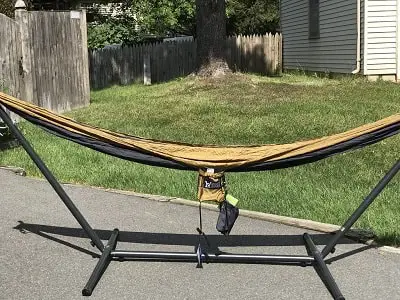Very often I tend to bring a hammock along when I go camping. There is nothing more relaxing than laying down on it after a long hiking day. Nevertheless, you can’t always tell what would your campsite feature. Many times I had no trees around me so that the hammock seemed like an unnecessary burden. That was when I decided to learn how to hang a hammock without trees.

There are six ways to hang a hammock without trees:
- Use a pair of posts or poles instead of tree trunks.
- Hang it from your car’s frame or roof rack.
- Purchase a portable hammock stand.
- Attach it to boulders from both ends.
- Hang it from public buildings (rain shelters, public parks, etc.)
- Use hammock structures found publicly.
1. Use Posts & Poles
If there are no trees around, you can use two poles to hang your hammock, but they have to be very strong so that you don’t end up falling to the ground because they have failed.
You can get these poles at a hardware store. For best results, you should get two poles, 8-feet long, and two eye bolts. You will need some cement too.
For each pole, dig a hole that is around two feet in depth, the put a little cement in it then drop your pole inside and put in more glue until the hole is filled up.
You should then dig the other hole about eight feet away and do the same with the second pole. And then, at the top of each of these two posts, you should screw an eyebolt, and you will have a system where you can hang your hammock.
Just don’t start using the hammock immediately, as the cement needs some time to dry. Otherwise, the entire system might come crumbling down if you hang the hammock and climb on it quickly.
Today, you even have the chance to use a semi-permanent hammock post. This can be an especially great choice if you are setting up your hammock in a campsite where rules and regulations would bar you from making any permanent changes to the site by digging holes and using cement to set up the posts.
With these poles, you only need to make a hole about a foot deep, and you will not have to use cement to make the posts offer a secure place to hang your hammock.
You can also make use of fence posts and even telephone posts. Just make sure that whatever post or pole you use is strong enough to handle the weight of the hammock while in use.
Also, be sure to use posts and poles that will not get you into any problems with anyone. That said, concrete fence posts can be pretty good support for a hammock.
2. Using Your Car’s Door Frame or Roof Rack
Besides keeping you warm, your vehicle can help you hang your hammock without the need for any trees. The process is a lot similar to that of hanging a hammock using poles, to some extent.
This technique is more natural because you need only a single pole unless you have two cars with you in which case you might not need any poles at all.
However, if you have to use a pole, you might not be in a position to use cement to fill in the hole in case you are in a public park. So, you would have to use other techniques to ensure that the pole is firmly in place by other means.
For instance, you can use gravel to fill in the hole before compacting it with soil so that the pole is firmly in place. An eyebolt would also be required so that you can tie the hammock securely to the pole.
The pole also needs to be about 8 feet from the doorframe or the rack on which the other end of the hammock has been tied to. Otherwise, the other end of the hammock should be tied to your car’s frame or its roof rack securely.
This technique should obviously lower your workload and your costs as you only need to buy a single pole and bolt and you would not need to dig two holes. With two cars, the process can be even much more comfortable since no poles would be required.
Another way to use your car is by creating a car hammock stand. With this technique, you will be using the car’s weight as leverage. Take a close look at the following video for a better visual understanding.
3. Using Portable Hammock Stands
These days, you do not need to be a DIY expert to make a hammock work without the need for trees. You can also buy hammock stands, and these are often lightweight and easy to carry around.
They are also designed compactly so that taking them around is not too much of a hustle. If you don’t want to buy any stands, you can even make your own using poles or bamboos if you have the DIY skills to pull it off.

One crucial factor to consider is whether the hammock you are using is suited to these kinds of stands. In addition to that, you should do enough tests to ensure that your hammock will be safe to use once it is hung on these stands.
Hammock stands or frames are especially great for urban areas where trees are not an option as you hang your hammock. These frames feature different shapes and sizes, but most are made of two long supporting rails that sit parallel to each other on the ground.
Thoughtfully, these frames also come with hooks from which you can hang your hammock. While these hammock frames can offer you a lot of conveniences, it is essential to get the right frame for your needs.
So, you should consider the size and the lightness of the frame as well as it’s sturdiness. Some frames are made of many parts that can be joined together to make a complete frame.
Some hammock frames can accommodate a tarp of a rain fly, which means you can still be comfortable and dry and in your hammock even when it begins to rain.
Hammock stands are also great if you are setting up at a place such as a beach, where you cannot dig holes of set up firm posts on which you can tie your hammock.

Just be sure to get a good quality hammock, and you will have an excellent experience with these hammock supports.
4. Hang the Hammock on Boulders
This technique, while it can work brilliantly, also needs a lot of care as boulders are often found in dangerous places where you can slip and easily injure yourself.
So, you should not be above getting help from fellow campers if necessary to set up your hammock using boulders. Another vital thing to consider is whether the hammock is securely tied to the boulders.
But you also have the benefit of not having to worry about these firm supports giving in, since boulders are pretty solid, obviously.

Another issue you have to consider is how safe the area you are hanging your hammock is. For instance, there might be thorny bushes, sharp stones, and so forth beneath the area you are hanging your hammock.
Basically, the hammock should be set up above a clean and plain ground. Therefore, setting up your hammock on two boulders across a deep ravine is a terrible and dangerous idea.
For the sake of your safety, you should avoid putting up your hammock in such areas as an accident could result in severe injuries for you.
It could be that one of the places the hammock ropes passes through is pretty sharp, and some wiggling within the hammock might slowly cut the string until it snaps.
5. Using Buildings
In the absence of trees, you can use buildings to hang your hammock. For instance, you could be close to structures such as rain shelters or close to a side of a building.

Coincidentally, public parks and state parks where many campers like to visit often have buildings which you can use to hang your hammocks in case there are no trees around.
This might be an especially meaningful way to set up your hammock considering that any available trees might be too deep in the woods.
In this case, you can find a building with sturdy posts or other places where that can offer strong support for your hammock. But even though buildings can give you a convenient location for your hammock, you have to be cautious about some things.
For instance, you should ensure that the supports in questions are strong enough to handle the weight of the people who will be using the hammock.
Additionally, make sure you do not make any permanent alterations to the buildings and structures, as that might get you into problems with those in charge of them.
6. Using Hammock Structures
Some places have hammock structures. So you do not even have to consider using any trees as you enjoy your time relaxing on a hammock with these thoughtful structures close by.
Besides, you can share a hammock with other people pretty conveniently. That is not always the case with trees, which can dictate how far apart you can be as you set up your hammocks.

These structures also tend to have great shades to protect you from the rain in case the weather changes. Fortunately, these structures are relatively common in places like colleges, public parks, and other areas within the city.
So, you can actually rely on hammock structures offering you the support you need to set up your hammock as you travel around on fun outdoors camping trip.
Clearly, if you are not a DIY fan, using a park with a hammock structure is a pretty good idea as you do not have to put together any hammock stands or start working with tools as you dig holes to set up poles that can support your hammock.
These structures also reduce the chances of the hammock failing during use, which has been known to happen in some scenarios, especially when using weak improvised hammock supports.
What is The Right Way to Tie my Hammock?
It doesn’t matter what method you’ve chosen; the principle of hanging a hammock remains the same. Note that with all the mentioned techniques, you would end up with two stable structures that will hold your portable bed (posts, poles, door frames, etc.).
The next step would be tying the hammock to these supports. To do so, I suggest that you take advantage of the Bowline knot, which could also serve you in hanging a tarp for shade; which you should.
Tying Description:
- Wrap a sustainable rope around your support.
- Create a loop on one end and pass the tail through it.
- Wrap the tail around the working head once more and pass it through the loop again.
- Pull both endings to tighten.
Now you have a solid knot that goes around your support. This knot should hold your weight, therefore make sure you follow the instruction precisely.
If you wish to learn a few more of these, I recommend that you read my in-depth article on 15 essential camping knots that actually work and used worldwide. Now, all you have to do is tie both parts to your hammock; the following video you teach you how to do it right.
When you are using boulders, door frames and buildings to hang your hammock, things might be a little different. The reason for that is that you lack the longitudinal shape trees, poles and posts feature. Therefore, it might be a bit more complicated to tie the knots properly.
Nevertheless, the old rules still apply, and the knots you should be using are precisely the same. Using these features requires some improvisations – merely ensure you have enough working area to tie the knot stably.
How Far Should a Hammock be Off The Ground?
I was searching quite some time an accessible tool which would allow me to calculate the desired height of my hammock.
The deeper I’ve dug into it, I realized the answer to this questions depends on many factors; the distance between trees, your weight, the hammock’s length, etc.
That was when I came across this calculator, provided by theultimatehang.com. All you have to do is to correct the current values in a way they match your own.
Do not listen to rule thumbs and to people who tell you a precise number; it varies a lot.
How Much do These Methods Cost?
Boulders, car frames, buildings, and hammock structures obviously cost you nothing, since you take advantage of the support that is already there. On the other hand, you would probably have to invest in getting yourself a hammock stand or a post.
When I was searching the internet, I saw that stands’ price is quite even and is around 40$. Some would cost more and other less, although those you purchase shouldn’t be much far from this number.
Posts, on the other hand, vary quite a lot in price. The reason for that is that it depends on the type you decide on buying. Fence posts, for example, cost between 20-40$.
Should I Insist on a Place With Trees?
In my opinion, the mentioned techniques work fine, and you shouldn’t insist on a place with trees to hang your hammock at. Nevertheless, it really depends on how well you follow the instructions and assemble the parts correctly.
You should keep in mind that trees are robust and would probably hold your hammock best. When you forsake these and go with alternative methods, you should compensate it by creating a solid structure to lay down on.
On the favor of these alternatives, you should also keep in mind that hanging a hammock on trees gradually damages them.
When I’ve used mine on my backyard for an extended period I’ve noticed a few rubbings on the trunk and was entirely moved by it. If you care about preserving nature, hanging a hammock without trees might be the right way to go.
Conclusions
Even if your campsite doesn’t feature trees, you could still hang up your tarp correctly and enjoy a pleasant nap. All you have to do is find a replacement.
You could take advantage of existing objects, such as boulders or buildings. Also, you could bring your portable tools from home; poles, posts or perhaps a hammock stand.
The crucial point is that you have to build it thoroughly with extra cautious – otherwise your bed might collapse. Remember that tree trunks are one of the most robust support you will find, and now you have to build one of your own.
I hope my article had shed some light on how to hang a hammock without trees. If you have any new insights – let me know all about them by leaving a comment below!

